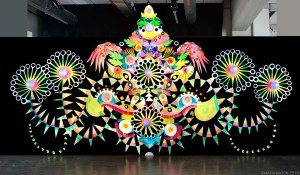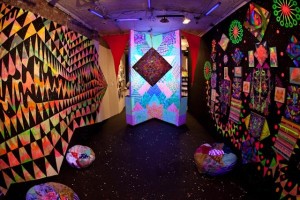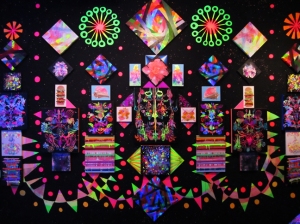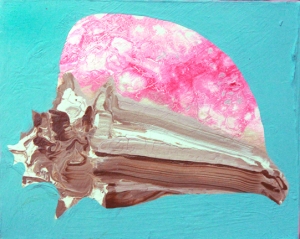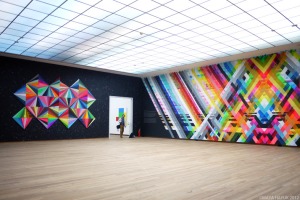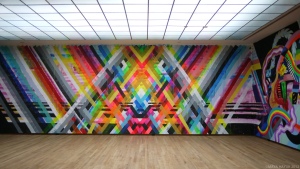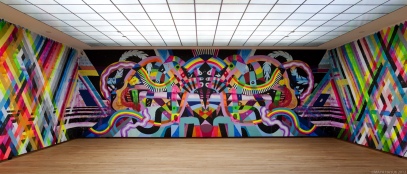Maya Hayuk-Project II
Maya Hayuk
“Hayuk weaves visual information from her immediate surroundings into her elaborate abstractions, creating an engaging mix of referents from popular culture and advanced painting practices while connecting to the ongoing pursuit of psychedelic experience in visual form.” (Hammer Projects, Maya Hayuk)
Maya Hayuk is a Brooklyn based artist, born in 1969 in Baltimore. She describes her childhood as relatively uneventful-she wasn’t a troublemaker or a rebel, as you might expect from a future street artist. She was involved in her school and community, and has said that staying out of trouble left her to pursue other interests. She graduated from the Massachusetts College of Art and Design with a BFA in 1991, and has also studied at the University of Odessa and the Skowhegan School of Painting and Sculpture. Despite this, she stated in an interview with Fecal Face (an art and pop culture website) that the majority of her education came from experience rather than formal academics. “The most important part of my education hasn’t come from school – the travels I did with my parents (geography and psychology professors), who took their students to Europe, Africa and the Soviet Union, growing up in Baltimore, living in Richmond, Boston and Toronto, then San Francisco for 10 years, being in and out of love…”
In college, Maya focused less on visual art and more on other artistic and musical studies, since, as she states, “(I) never really studied painting or photography formally, because I was already painting and making photos.” Hayuk’s work usually does not emerge from a pre-conceptualized idea, but rather takes form during the process of making. Many of the boundaries for her work, she states, actually come from her supplies. The colors she uses and the physical scope of the piece she is working on are both determined by what she has available.
Hayuk adheres to the general idea of rebel culture in her work, as the vast majority of street artist’s do, but her form of rebellion is much more inherent. Street artists tend to create works that have a message, some form of social significance- Hayuk’s art, however, embodies a form of counter culture. A dichotomy of abstract, psychedelic form and strict, definable geometry is used to loosen the boundaries on the viewer’s perception-her work allows the viewer to reimagine the world around them in a completely new way. Works of art by Hayuk embody the psychedelic, free-form methods of thinking that oppose dominant social norms.
Hayuk’s work is usually part of a collection or exhibition, and is meant to be viewed in the context of her other pieces. Because of this, I preformed research that was more general, rather than specific to one panel/wall of her work. These were the three collections I researched: Heavy Lights, Heavy Light, and Fucking People. (All images taken from http://mayahayuk.com/ or http://cindersgallery.com/)
Heavy Light:
Heavy Light (not to be confused with “Heavy Lights”) was a 2010 Cinder Gallery Exhibition. The gallery showcased, for the most part, smaller scale works by Hayuk. This gallery was organized to optimize the viewer’s immersion in the art pieces present, “suggesting that the viewer is actually the source of light.” Many of the ideas presented are similar to those found in “Heavy Light” but the presentation of these ideas is different. The gallery is composed of many small scale works, and they vary in style and form. Some even show fairly uncharacteristic work, such as plain acrylic on canvas pieces depicting objects. Many of the pieces have backdrops similar to those found in “Heavy Light” but the style changes significantly-Hayuk works with fractals in these pieces, and a sense of radial/planar symmetry. The organic nature of the pieces is similar, but these works have an actual sense of organized form.
Heavy Lights:
Heavy Lights was a 2012 exhibit shown in the Bonnefaten Museum in the Netherlands. This exhibition consisted of four large murals, one on every wall of the room, spanning the distance from the floor to the ceiling. The use of color in these murals sticks to the traditional pallet of Hayuk’s work; extremely bright, vivid and contrasting colors were used in their creation, in very strong contrast with the black backdrop. Two opposing walls are covered in an interwoven, linear pattern with little organic deviation. This is a style symbolic to Hayuk’s work. The back wall features a less encompassing point of focus, a group of boxes fitting together in the center of the space. Each box consists of a series of radiating beams of light, of many varying colors, meeting at the center of each cube. The space surrounding this central graphic is composed of black paint, with little pinpricks of light; a backdrop of the universe. The central graphic is completely divorced from the geometric nature of the other murals. Extremely organic designs radiate outward across the entire wall, interlaced with the black backdrop of the opposite wall. There is no definite shape or figure in this graphic, but the complex interwoven design stimulates the viewer’s imagination. Defined figures seem to leap out from the canvas, before being lost in the organic chaos of the piece. The title of the exhibit, “Heavy Lights” is indicative of the idea she illustrates. The attention to negative space, the backdrop of stars, contrasts the vivid, immediate nature of the colorful designs. She makes light and color tangible, allowing the viewer to immerse themselves in the piece. The backdrop holds a great deal of significance, as it is indicative of this idea of infinity.” I’m fascinated with the idea of traveling through time and space. Though it might sound simplistic, it’s where I “go” when I paint. I love the polarity and poetry of something being both heavy and light in weight and space. Plus, I tend to say the word “heavy” a lot to express joy.”
Fucking People:
“Fucking People” is a series of wooden panels made by Hayuk that displays, as the title may suggest, acts of intercourse. The panel shown is one of many that detail an abstract symmetry of such an act, overlaying the features of the interlocking bodies over and into each other. The piece adheres to Hayuk’s method of color use, using vivid, bright colors to distinguish the different parts of the piece. These works are a more down to earth expression of sensory exploration; most of Hayuk’s work is metaphysical in nature, encouraging the viewer to relax the boundaries of their senses and transcend. These panels are intended to depict the joy of pure physical existence, in all its simplicity. Hayuk sees these as confrontational pieces as well. As she states in her “Fecal Face” interview: “I guess this is partially a reaction to this abstinence only campaign that I’m not so stoked on…how can you argue with what this is about? You know, its love.”
Critique of “The Making of Space, Race and Place:
This article, by Maggie Dickinson, summarizes the rise of graffiti as an art form in New York, and details the governments war against this form of expression. Dickinson states that the traditional graffiti artist does not enter into his work with the intentions of filling an oppositional role-they simply see what they are doing as a form of expression, a method of beautifying otherwise dull, colorless expanses of urban fabric. It is government intervention, and the criminalization of the act of graffiti, that forced street artists into the role of counter culture criminals. This intervention was seen as necessary because it indicated a governments lack of control over a given area. Their inability to reduce graffiti (at least at first) only made this situation worse, as they had to justify the allotment of taxpayer dollars to cleaning up graffiti during a time of fiscal crisis. This forced role of opposition sparked a sense of rebellious intention in the writing youth-what had originally been harmless tags became a form of expression and communication with anti-establishment intent. Modern street artists such as Banksy epitomize this role, but Maya Hayuk differs greatly in regards to her intentions. She does have a counter culture language to her work, but it is embodied in her message of spiritual and metaphysical transcendence, rather than a social message. Hayuk opposes social norms, but by nature rather than intent; this is the distinction that I feel is important.
Bibliography:
Maya Hayuk, retrieved Jan. 15 2015, http://mayahayuk.com/
Maya Hayuk Interview, Pub. Feb. 11 2008, retrieved Jan. 15 2015, http://www.fecalface.com/
Bobila, Maria, Street Artist Maya Hayuk Brings Trippy Paintings to Cinders Gallery, Pub. Nov. 21, 2014, retrieved Jan. 15 2015, http://ca.complex.com/
Peipon, Corrina, This Event Begins the Moment you Finish Reading This, retrieved Jan. 15 2015, http://hammer.ucla.edu/
